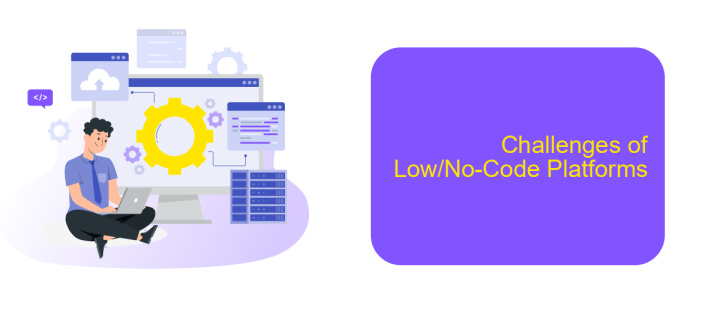Low No-Code
In today's rapidly evolving tech landscape, the demand for faster and more efficient software development has never been higher. Low-code and no-code platforms are revolutionizing the way businesses approach application creation, enabling even non-technical users to build robust solutions with minimal coding. This article delves into the benefits and challenges of adopting low-code and no-code technologies, exploring their impact on the future of development.
Introduction
Low No-Code platforms are revolutionizing the way businesses develop and deploy applications. By eliminating the need for extensive coding knowledge, these tools empower a broader range of individuals to participate in the software development process. This democratization of technology fosters innovation and accelerates time-to-market for new solutions.
- Ease of use: Intuitive interfaces allow users to build applications with minimal training.
- Cost efficiency: Reduces the need for specialized developers, lowering overall project costs.
- Flexibility: Easily adaptable to changing business needs and requirements.
- Speed: Rapid prototyping and deployment capabilities.
- Integration: Seamless integration with existing systems and third-party services.
One notable service that enhances integration capabilities is ApiX-Drive. This platform simplifies the process of connecting various applications and automating workflows, enabling businesses to streamline operations without extensive coding. By leveraging tools like ApiX-Drive, organizations can maximize the benefits of Low No-Code solutions, driving efficiency and innovation across their operations.
Benefits of Low/No-Code Platforms

Low/No-Code platforms offer significant benefits for businesses of all sizes. One of the primary advantages is the accelerated development process. By enabling users to create applications without extensive coding knowledge, these platforms reduce the time it takes to bring a product to market. This agility allows companies to respond quickly to market changes and customer needs, fostering innovation and competitive advantage.
Another key benefit is cost efficiency. Traditional software development often requires substantial investment in skilled developers and long development cycles. Low/No-Code platforms, however, lower these costs by empowering non-technical staff to build and maintain applications. Moreover, platforms like ApiX-Drive facilitate seamless integration with various services, streamlining workflows and enhancing productivity. By simplifying complex integration processes, businesses can save time and resources, focusing on core activities and strategic growth.
Use Cases for Low/No-Code Platforms

Low/No-Code platforms have revolutionized the way businesses approach software development, enabling non-technical users to create applications with minimal coding knowledge. These platforms are particularly useful in several key scenarios:
- Rapid Prototyping: Quickly build and test prototypes without extensive development cycles.
- Automating Business Processes: Streamline repetitive tasks through automation, reducing manual labor.
- Custom Integrations: Easily connect various software tools and services using platforms like ApiX-Drive, which simplifies API integrations.
- Internal Tools: Develop internal applications tailored to specific needs without relying on IT departments.
- Data Management: Create custom dashboards and reporting tools to better visualize and manage data.
By leveraging Low/No-Code platforms, organizations can significantly reduce development time and costs, empowering teams to focus on innovation and strategic initiatives. Tools like ApiX-Drive further enhance these capabilities by offering seamless integration solutions, making it easier to connect and automate workflows across different software applications.
Challenges of Low/No-Code Platforms

Low/No-Code platforms offer numerous benefits, but they also come with their own set of challenges. One significant challenge is the limitation in customization. While these platforms provide a wide range of pre-built templates and components, they may not always meet the specific needs of every business, leading to potential limitations in functionality.
Another challenge is the integration with existing systems and third-party services. Although platforms like ApiX-Drive can facilitate integrations, ensuring seamless data flow between different systems can still be complex and time-consuming.
- Scalability issues when dealing with large-scale applications
- Security concerns due to limited control over the underlying code
- Dependency on the platform provider for updates and support
- Potential hidden costs associated with premium features and add-ons
Despite these challenges, Low/No-Code platforms continue to evolve, offering more robust solutions and addressing many of these concerns. Businesses must carefully evaluate their specific needs and constraints to determine if a Low/No-Code approach is the right fit for their projects.


Best Practices for Low/No-Code Development
When embarking on low/no-code development, it is crucial to start with a clear understanding of your project requirements. Define the scope, objectives, and desired outcomes to ensure that the chosen platform aligns with your goals. Additionally, prioritize user experience by involving end-users in the design process and gathering their feedback. This can help in creating intuitive and user-friendly applications that meet the actual needs of the users.
Another best practice is to leverage integration tools like ApiX-Drive to streamline data flow between different systems. ApiX-Drive allows for seamless integration of various applications without the need for complex coding, enhancing efficiency and reducing manual work. Regularly testing and iterating on your application is also essential. Conduct thorough testing at each development stage to identify and resolve issues early. Finally, ensure proper documentation and training for users to maximize the adoption and effectiveness of your low/no-code solutions.
FAQ
What is Low No-Code?
Who can benefit from Low No-Code platforms?
How does Low No-Code improve productivity?
Can Low No-Code platforms integrate with existing systems?
Is it secure to use Low No-Code platforms for business applications?
Apix-Drive is a universal tool that will quickly streamline any workflow, freeing you from routine and possible financial losses. Try ApiX-Drive in action and see how useful it is for you personally. In the meantime, when you are setting up connections between systems, think about where you are investing your free time, because now you will have much more of it.

